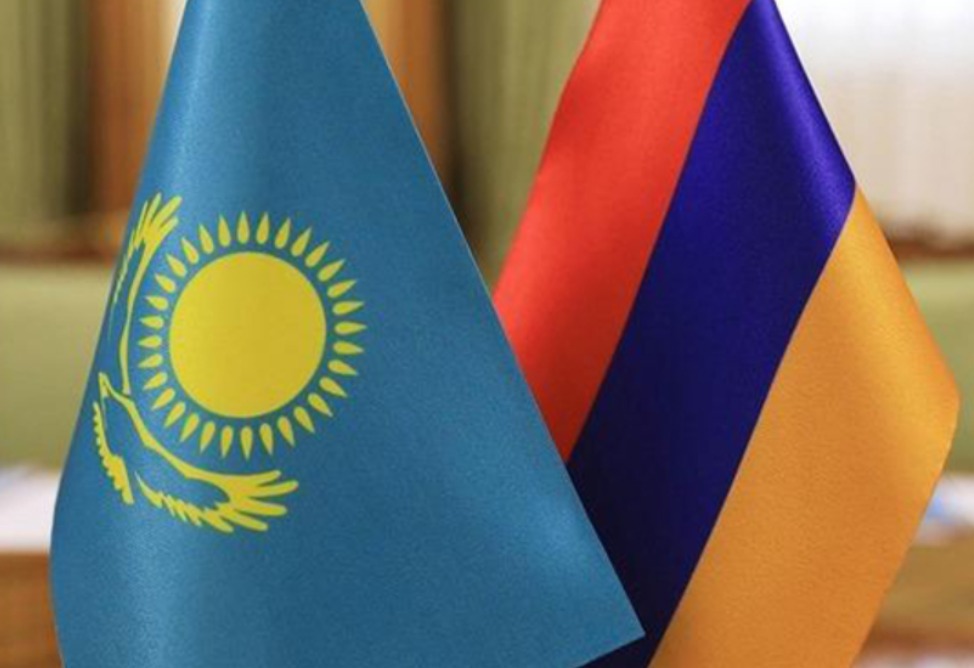IMF to revise forecasts on Armenia's economic growth and expects inflation to stabilize at around 4%

YEREVAN, September 7. /ARKA/. In an exclusive interview with ARKA news agency Jihad Azour, Head of Middle East and Central Asia Department at the International Monetary Fund (IMF), speaks about IMF’s vision regarding prospects of Armenia's economic development, inflation behavior and national currency, as well as about the goals of the IMF’s Stand-by Arrangement program
ARKA- In April, the IMF improved the forecast for Armenia's GDP growth to 5.5%. What are the current expectations regarding the growth of the Armenian economy by the end of the year, what factors are decisive in the development?
Azour- Growth in Armenia continues to be very strong, reaching 10.5 percent in the first half of 2023 supported by expansion in the services, construction, and trade sectors. Relocation of individuals, businesses, and capital from Russia has largely contributed to the remarkable growth in economic activity in 2022-23. Nonetheless, deceleration towards the end of the year, as the impact of migration and capital inflows on growth dissipate, is likely to ease growth from its current very high rate. Our revised growth projections will be available after the conclusion of the discussions for the second review under the Stand-By Arrangement and Article IV consultation in September.
ARKA- A number of experts explain the double-digit economic growth in the country, mainly, by the inflow of a large amount of funds, in particular, relocators from Russia. On the other hand, many people are not very excited about the appearance of so many non-residents on the market. How would you assess the impact of this factor on the economy of Armenia. Is it possible to consider development scenarios based on this factor, taking into account quite an uncertainty of the latter?
Azour - The war in Ukraine resulted in a range of cross-border developments. A surge in tourist arrivals in Armenia, with visitors staying longer and spending more, has resulted in unprecedented services trade surplus of almost 9 percent of GDP in 2022. Exports in goods, mostly due to re-exports, increased by 75 percent. Foreign direct investment and other inflows also picked up. These developments have played a major role in boosting Armenia’s economic growth.
However, there is great uncertainty about the medium-term impact of these developments. If international visitors who are of working age and have high level of education remain in Armenia permanently, the labor force, productivity, and output may be higher. Growth of foreign direct investment and newly registered companies is another sign that potential output may increase more than projected. But Russia’s growing share in Armenia’s exports increases the risks to the economy if Russia’s growth falters.
All these developments underscore the need to press ahead with reforms to improve the business environment and the labor market, deepen capital markets, and diversify Armenia’s export basket and trading partners. Increasing fiscal and foreign exchange buffers is also needed to face potential adverse shocks.
ARKA- What do you think, what are the most promising areas of the Armenian economy for investments?
Azour In my meetings with Armenia's policymakers during my recent visit, they widely acknowledged the need to facilitate export-led and knowledge-based growth in Armenia. This is one of the objectives of the Government’s 2021-26 program. It is not as much about investing in specific sectors as it is about developing a strategic approach to help Armenia’s economy to pivot towards external demand.
Boosting diversification and improving the economic complexity and sophistication of products and services produced in Armenia will be essential. This will require completing a broad set of structural reforms, such as improving the quality of infrastructure, including transport networks and telecommunications, reducing nontariff barriers including documentary and border costs, investing in health, and strengthening education and research.
ARKA- In June, the IMF expected that inflation in Armenia would stabilize at the level of the Central Bank's target of 4% during the year. In the past two months, there is an evidence of deflation in the country: in June, prices decreased by 0.5%, and in July - by 0.1% in annual terms. Will the IMF change its inflation forecast for Armenia? If yes, what indicator is expected by the end of the year and under what prerequisites?
Azour - Let me use this opportunity to commend the Central Bank of Armenia for being one of the most proactive central banks in addressing high inflation in 2021-22. The increase in the policy rate to 10.75 percent during that period helped contain inflation and inflation expectations.
In the last few months, the inflation rate has come down unexpectedly fast, which is due to dram appreciation, and falling food and transportation prices. These recent inflation developments underscore that uncertainty to the outlook remains very high. On one hand, food and commodity prices and rapidly subsiding inflation in trading partners are expected to put downward pressure on inflation. On the other hand, high wage growth and credit expansion together with strong domestic demand may keep inflation pressures elevated. As with other economic projections, our staff are now working on revisions that will be finalized after the September mission. We expect that CBA’s monetary policy will help stabilize inflation around 4 percent in the period ahead.
ARKA- According to EDB analysts, the Armenian Dram has shown a steady appreciation against the currencies of trading partner countries since the beginning of Q2 2022: according to the results of July of this year, compared to the beginning of 2022, the Armenian Dram has strengthened in annual terms by 19.8% against Dollar, by 21.7% against Euro, and by 32.4%. against Russian Ruble. At the same time, the Central Bank of Armenia does not see the prerequisites for the devaluation of Dram, but considers the scenarios of both strengthening and weakening of the exchange rate as possible. What are the scenarios for the behavior of the Armenian currency by the end of the year?
Azour- You are correct in noting that the dram appreciated significantly against the currencies of Armenia’s key trading partners since the start of the war in Ukraine, which is largely explained by the strong capital inflows. Like the CBA, we also see risks on both sides. On the one side, a potential reversal of these inflows could put downward pressure on the dram. On the other side, should the inflow of capital continue to be strong further appreciation of the dram is also likely. In either case, it is important for the right policies to be in place so that the economy and the financial system are robust and temporary exchange rate movements do not have a significant impact on them.
ARKA- Experts from the Fitch Ratings agency expect the stabilization of Armenia's public debt in 2023-2025 at a level of about 44.6%, which is lower than its pre-pandemic level of 53.7% in 2019. Does the IMF agree with this assessment, and what factors will be the most determining?
Azour - Public debt declined very sharply in 2022 and in 2023H1. The central government debt stands at 42.7 percent of GDP in the first half of 2023. While we expect central government debt to remain below 50 percent of GDP in the medium term, the outcome would depend upon the implementation of a gradual fiscal consolidation supported by prioritization of spending and revenue mobilization measures. Furthermore, Armenia’s debt has historically been vulnerable to growth and exchange rate shocks, and any adverse shock to the outlook could put significant upward pressure on debt. Therefore, fiscal policies need to remain prudent to keep central government debt at moderate levels.
ARKA- What recommendations would you give to the Government of Armenia on measures to support the country's economy and implement reforms? What are the prospects for cooperation under the Stand-by Arrangement?
Azour - The IMF Executive Board Approved a 36-month precautionary SBA on December 12, 2022, which supports the authorities’ efforts to preserve macroeconomic, financial, and fiscal stability and to advance their homegrown economic program. The first review of the program was successfully completed in June, and discussions on completion of the second review will take place in the Fall. On the specific objectives of the IMF-supported program:
- Preserving macroeconomic, financial, and fiscal stability requires: (i) Fiscal policy that remains appropriate for the phase of the economic cycle and supports Armenia’s development spending needs, is anchored by the fiscal rules, and will keep public debt moderate; (ii) monetary policy that is consistent with steering inflation toward the CBA target of 4 percent over the medium term; (iii) exchange rate flexibility and maintaining healthy reserve buffers; and (iv) further strengthening of the regulatory and supervisory framework to keep financial sector risks in check.
- A higher, export-oriented, and more inclusive growth could be achieved with a package of structural reforms that aims to facilitate trade, diversification, and FDI; develop infrastructure and connectivity; strengthen governance; improve the business environment; foster employment and social protection; advance digitalization; and build resilience against climate risks. Reforms in these areas complement efforts supported by other development partners.
The Armenian authorities continue to treat the SBA as precautionary, which is appropriate, given the availability of financing and ample international reserves. In the event of an adverse shock, the SBA aims to provide a positive market signal, catalyze support from other International Financial Institutions, and serve as insurance against potential external financing needs.
ARKA- How would you evaluate the actions of the Central Bank of Armenia in the context of the monetary policy effectiveness, in particular, the efforts to promote capital market development and liquidity management?
Azour - The inflation-targeting framework is working well and has benefited from CBA’s proactive policy actions and efforts to improve communication and develop capital markets. The authorities have recently created an over-the-counter commercial trading platform for the overnight repo market and for the FX market transaction.
We have just published an IMF departmental paper on Monetary Policy Frameworks in the CCA, in which we identify main factors that affect monetary policy effectiveness in the CCA countries. First, financial markets remain relatively shallow, which weakens the interest rate, bank lending, asset price, balance sheet, and expectations channels of monetary transmission. Second, dollarization is still high, despite its gradual decline over the last decade. Third, central bank credibility and communication are hampered, in an environment of low trust in public institutions and low financial literacy. Therefore, there is further scope to strengthen the operational framework by developing financial markets and improving liquidity forecasting. -0-



